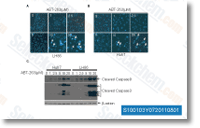Metastatic lesions through the osteolytic tumors had been microdissected into two cohorts TB inter encounter and TA region and gene expression profile analyses were carried out. Herein, we reanalyzed these gene expression information sets searching for a breast cancer osteolysis unique gene signature. Our reanalysis illustrates that there’s little similarity in gene expression during the TA location samples amid the 3 cell lines. That is altogether not also surpris ing given that these cell lines were originally derived from numerous mouse tumors. Regularly, the sublines Cl66 and Cl66 M2, share probably the most simi larity in gene expression. The TA location was grown within a non canonical tumor microenvironment and as this kind of might be thought to be a metastatic tumor. Nevertheless, we still assume that the gene expression profile from your TA place will resemble previously reported profiles for your cell lines utilized in this review, primarily offered the truth that the pri mary tumor and its metastatic tumor happen to be reported to have related gene expression profiles.
To verify that the TA spot expression signature of each cell line resembles selelck kinase inhibitor that of principal tumors, we selleck chemicals Selumetinib used a public gene expression profile of tumors grown inside the breast through the 4T1 and Cl66 cell lines. Reassuringly, the up regulated genes in the TA spot of 4T1 cells substantially predicted key tumors from 4T1 cells along with the down regulated genes predicted tumors from Cl66 using the NTP algorithm. Because the gene signature through the TA area of 4T1 cells are reported rela tive to Cl66 and Cl66 M2, almost all of the down regulated genes represent these up regulated in Cl66 and Cl66 M2. These effects show the gene expression profile from our microdissected TA area samples represents that of major tumors.
In an work to translate our findings from our mouse breast tumor model to human disease, we compared the gene expression profile from your TA place of our mouse model to that of main human breast tumors and cancer cell lines making use of the NTP algorithm. Specifically, we com pared microarray information from 118 principal breast tumor samples on the  gene expression profile from your 4T1 and Cl66 TA regions. Interestingly, 37 breast tumor samples had been substantially connected with 4T1 TA area and 34 breast tumor samples had been substantially linked with Cl66 TA spot with an FDR p 0. two. Our evaluation also predicted that 16 and three out of 54 human breast cancer cell lines resemble 4T1 and Cl66 tumors, respectively. Again, the down regulated TA spot genes signify the TA place of Cl66 and Cl66 M2. This examination predicts that it can be potential to use these 19 human breast cancer cell lines in our mouse model and that related effects could possibly be obtained.
gene expression profile from your 4T1 and Cl66 TA regions. Interestingly, 37 breast tumor samples had been substantially connected with 4T1 TA area and 34 breast tumor samples had been substantially linked with Cl66 TA spot with an FDR p 0. two. Our evaluation also predicted that 16 and three out of 54 human breast cancer cell lines resemble 4T1 and Cl66 tumors, respectively. Again, the down regulated TA spot genes signify the TA place of Cl66 and Cl66 M2. This examination predicts that it can be potential to use these 19 human breast cancer cell lines in our mouse model and that related effects could possibly be obtained.
Peptide Solubility
The prohormones are then packaged into membrane-bound secretory vesicles.
